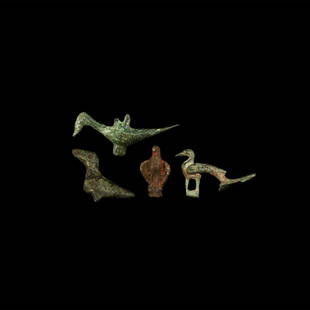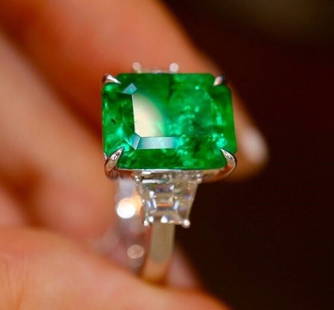
Roman Luna on Globe Statuette
Similar Sale History
View More Items in Brooches & PinsRelated Brooches & Pins
More Items in Brooches & Pins
View MoreRecommended Jewelry
View More


Item Details
Description
2nd-3rd century AD. A bronze statuette of Luna standing on a globe, in advancing pose with loose peplos clasped at the shoulders by disc brooches, left hand raised and open, right hand slightly extended, hair dressed in a chignon with scrolls to the brow and crown; the eyes, fingernails and toenails with sheet silver detailing; globe mounted on a tiered pedestal base, hollow to the underside. Cf. Ward Perkins, J. Pompeii AD 79, London, 1976, items 176 and 223. For a similar statue from Saône-et-Loire,Mâcon, France, see The British Museum, accession number 1824,0426.5 Accompanied by an Art Loss Register certificate. 666 grams, 22cm (8 3/4"). Property of a Surrey collector; acquired in the early 1970s. Supplied with a positive X-Ray Fluorescence metal analysis certificate, and accompanied by a copy of positive metallurgic analytical results, written by Metallurgist Dr. Peter Northover (ex Department of Materials, Materials Science-Based Archaeology Group & Department of Materials, University of Oxford"). Luna was the personification of the moon, equivalent to Greek Selene, often shown as an aspect of the Roman triple goddess (diva triformis), along with Proserpina and Hecate. Her billowing robes represent the endless forward motion of the goddess in her celestial chariot, while the silver detailing of the figure evokes moonlight. Her chief temple was on the Aventine Hill in Rome. Her Greek name means, light or radiance, and she was the daughter of the Titans Hyperion and Theia, and sister to Helios, the sun god, and Eos, goddess of the dawn. Several lovers are attributed to her in various myths, including Zeus, Pan, and the mortal Endymion. In classical times, Selene was often identified with Artemis, much as her brother, Helios, was identified with Apollo. The poet Aeschylus calls Selene the eye of the night and other ancient literary references describe her the bright and beautiful haired. The Orphic Hymns give Selene horns and a torch, describing her as all-seeing, all-wise, a lover of horses and of vigilance, and a foe of strife who gives to Nature's works their destined end. Paired with her brother Helios, Selene adorned the east pediment of the Parthenon, where the two framed a scene depicting the birth of Athena, with Helios driving his chariot rising from the ocean on the left, and Selene and her chariot descending into the sea on the right. From Pausanias, we learn that Selene and Helios also framed the birth of Aphrodite on the base of the Statue of Zeus at Olympia. There are indications of a similar framing by Selene and Helios of the birth of Pandora on the base of the Athena Parthenos. Selene also appears on horseback as part of the Gigantomachy frieze of the Pergamon Altar. Due to her association with the moon she was the tutelary deity of magicians and sorcerers.
Condition
Very fine condition.
Buyer's Premium
- 27%
Roman Luna on Globe Statuette
Estimate £9,000 - £12,000
7 bidders are watching this item.
Get approved to bid.
Shipping & Pickup Options
Item located in London, ukSee Policy for Shipping
Payment

TOP





















































![Roman Artefact Group: 1st-4th century A.D. Including lead weights, acorn finial, Colchester-type bow brooch and other items. 547 grams total, 7-53 mm (1/4 - 2 1/8 in.). Found Cambridgeshire, UK. [71, No Reserve]](https://p1.liveauctioneers.com/1191/327724/176557806_1_x.jpg?height=310&quality=70&version=1714141989)






























